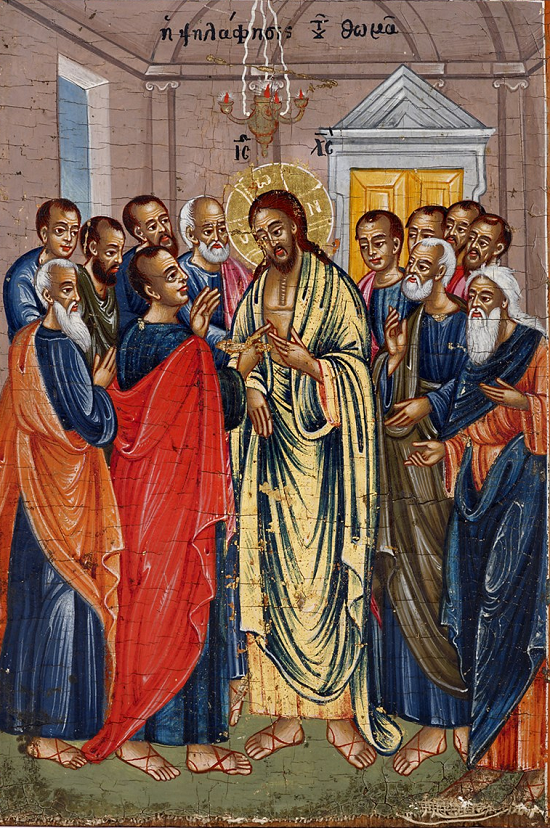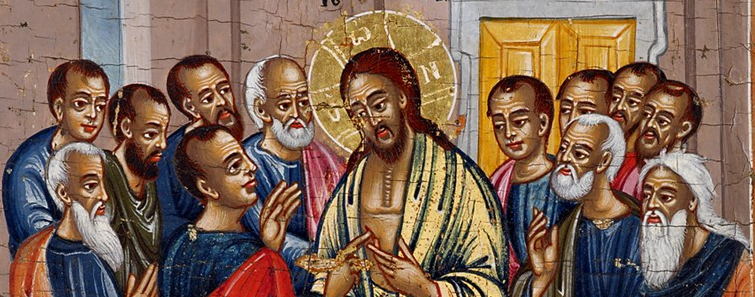As the Father Has Sent Me …
Second Sunday of Easter Scripture Readings

With this gospel reading from Saint John, we conclude our week-long celebration of the mysteries of Jesus’s Resurrection and the transformation of the Word who was in the beginning and who became flesh into the Word of the gospel alive in and through Christ’s disciples, his Church. This passage, which formed the original conclusion of John’s gospel, tells us all that John though it important for us to know about the Resurrection. Once again, John considers the historical details of time and place secondary to his exposition of their spiritual and mystical meaning.
John sets this most significant of Jesus’s appearances to his disciples on the first day of the week, that is, resurrection day, or Easter Sunday. A great deal had transpired between early that morning when Mary Magdalen encountered him at the tomb and that evening when the disciples were huddled together in a locked room out of fear. That morning, Jesus had told Mary, “Don’t hold on to me because I have not yet ascended to the Father.” Now, with his disciples, Jesus showed them his hands and his side. He even invites Thomas to experience the physicality of his resurrected body, seemingly contradicting what he had told Mary Magdalene that Easter morning.
What John is showing us is nothing less than the nature of the resurrection itself. He stresses for us the identity of the Jesus who appeared to them that evening with the Jesus of the crucifixion. His identity is established by his woundedness, and yet he comes and stands in their midst despite the locked doors. His wounded body, though physical, transcends physicality. Paul goes so far as to call it a “spiritual body” [1 Corinthians 15:44ֳֳ], a seeming contradiction in terms, but touching on the nature of resurrection itself for Jesus and, in faith, for us, as well.
When Jesus allows his disciples to see and Thomas to touch his wounded body, we must surmise that Jesus’s ascension to the glory of the Father has already taken place. The wounded Jesus of the appearances to the disciples is the glorified Jesus. We remember that, at the Last Supper when Judas had taken the morsel of food and had left the room, Jesus had said to the remaining disciples, “Now is the Son of Man glorified, and God is glorified in him.” [John 13:31] His ascension into glory began with his betrayal and culminated in his appearance to the disciples. So, for John, the “fullness of time” signified by the forty days between the resurrection and ascension as described in the Acts of the Apostles [1:3] was here condensed into a single day.
The climax of Jesus’s appearance as John described it occurred when Jesus gave his disciples—the embryonic Church—its mission and its power. He first offered them peace, not just the common greeting שָׁלוֺם עֳלַיכֶם (shalom aleichem), but a hearkening-back to the root of the term, שָׁלַם (shalam), meaning to be whole and entire. To be healed. He offered healing not only to each one as an individual but to the entire community of his followers. He offered them not only healing from their own individual faults and failings but also reconciliation from the weaknesses and divisions within their own community.
John says that he breathed on them—using the same wording found in the Book of Genesis for when God breathed over the waters of chaos to bring about the emergence of creation. As the resurrected Jesus was himself a new creation, he brought about the new creation of his body, the Church, out of the chaos of a fearful band of disheartened followers. As a sign—a sacrament, if you will—of the gift of this new creation, he said, “Receive the Holy Spirit,” the πνευμα (pneuma), the Holy Breath of God. The gift of the Holy Spirit brings about that wholeness, peace, forgiveness, reconciliation, and unity. It is as people made whole and knitted into a community—a Church—that Jesus sends them out into the chaos of the world to bring that healing to others.
Jesus said to Thomas, who had difficulty believing that God’s love could transform the pain and desperation of the crucifixion into anything good, “Have you come to believe because you have seen me? Blessed are those who have not seen and have believed.” Who are they? They are those who have received the Word of the gospels—the Good News—that God has renewed his creation and has brought something wonderful out of the chaos of hatred, pain, and death. It is we, the Church, the Body of Christ, who’ve been empowered by the Holy Spirit, the Breath of God, to bring reconciliation and wholeness to the alienated and the broken.
And yet, on a personal note, what gives me the most pain as we conclude our Easter celebration is watching as the Church—the Body of the Christ and the Word made flesh—allows itself to be overtaken by the forces of the world: wealth, power, and prestige. It not only lowers itself into the chaos of rancor, hatred, fear, and division, but it carries these sins into the world in the name of Christ. Not only is the message of the gospel being perverted by the wealth and covetousness, the pride and arrogance, and the hunger for power and control that corrupts the Christian Community at its core, but the so-called “witness” of these nominal followers of Christ give the anawim—God’s little ones—cause to hate Jesus, his Church, and everything we stand for. These “Christians” ignore what Jesus said, “It is better for [them] if a millstone is hung around [their] necks and [they are] thrown into the sea, than that [they] cause one of these little ones to sin.” [Luke 17:2]
What are we to do, then? What can we do so that those who have not seen may believe? What sign, what sacrament can we show the world that Jesus is alive and his Holy Spirit of peace and healing lives in us? Shall we become social media influencers and gather a large following? No. Prestige is a tool that Jesus never sought after nor cultivated. How about money-raising campaigns to help us spread the message of the gospel? No. Wealth just further alienates those poor and destitute for whom the Good News is intended. “The Son of Man has nowhere to lay his head.” [Matthew 8:20] Then certainly joining together into broad and influential political campaigns will impress people to follow Jesus. No. He never desired nor sought political power. On the contrary. He rejected it. In fact, whenever the Church has yielded to the temptation to seek wealth, power, or prestige, the gospel message has been silenced or perverted.
As I’ve said before, all we need to do to be effective missionaries of the gospel—the Good News—is to do as Jesus did. Accept who we are and where we are in the world as it is and not as we wish it were. Seek the will of God and the willingness and strength to carry it out to the best of our abilities. Forgive ourselves and one another for our shortcomings, faults, and failures. Live lives filled with gratitude for everything that comes our way—the difficult and painful as well as the easy and pleasant. Those are the things that make up the mission that the Father gave to Jesus, and that is the mission that the risen Christ has given us. Living that life of acceptance, surrender, and gratitude is our message and our gospel. It is to us that Jesus’s words are then addressed, “Blessed are [you] who have not seen and have believed.”
Get articles from H. Les Brown delivered to your email inbox.
